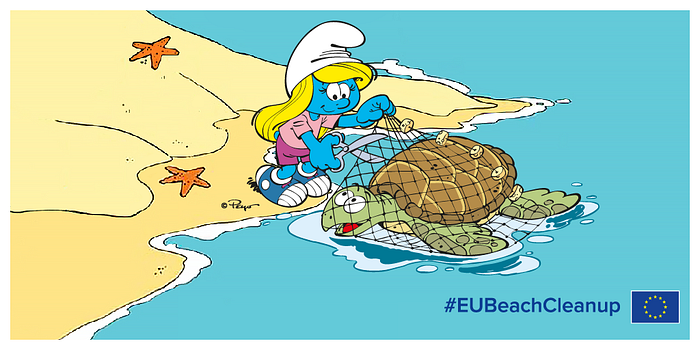5 ways the EU is working to fight plastic pollution
This year, the UN and the Smurfs helped us clean up our beaches as we take on this challenge while working to make the transition to a circular economy.

There are as many as 51 trillion microplastic particles in the seas — that’s 500 times more than stars in our galaxy.¹
Microplastics have been found in our food and drinks, including beer, honey and water. Since these particles are also ingested by marine animals, they are now a part of the food chain and they can impact our health in ways we might not be aware of today.
Plastics are everywhere. They are cheap, convenient and light. But we have to recognise that our addiction to plastics, especially single-use plastics which we use only for a few minutes but which can last up to hundreds of years in our environment, is leading to serious consequences. From changing our habits to encouraging a shift to a circular economy, we need to completely change the way we look at plastics.

1. Beach-clean up with Smurfs
By 2050, there could be more plastic than fish in the sea. This September was our third #EUBeachCleanup, and this time it the UN and the Smurfs helped organise events around the world to make our shores cleaner and protect marine ecosystems.

2. The first-ever EU-wide plastic strategy
In response to our December 2017 public consultation on single-use plastics, an overwhelming 98.5% of Europeans said it was “necessary” to act on single-use plastics, and 95% considered it “necessary and urgent.”
As a result, the first-ever Europe-wide plastics strategy started to take shape in early 2018. These EU rules will tackle 10 single-use plastic products (for which alternatives exist and are easily available) most often found on Europe’s beaches and seas, as well as lost and abandoned fishing gear by 2021. These include plastic cotton buds, cutlery, plates, straws, drink stirrers and sticks for balloons.
3. Ready for change?
Our campaign Be ready to change! aims at inspiring people to use sustainable and easily available alternatives to the ten most commonly found plastics on Europe’s beaches.
Together the 10 single-use plastics account for 70% of all marine litter items. So next time you go grocery shopping, you can take reusable bags with you. For your takeaway coffee, there are again practical and sustainable alternatives easily available. A nice reusable coffee mug could even reflect your personality!

4. All stakeholders, now on board
Our Plastics Strategy also focuses on getting the industry and producers involved to cover the costs of waste management and clean-up. The industry will be given incentives to develop less polluting alternatives for these products. We have already received over 70 pledges, including from many big names in the industry that will promote recycled plastics.
As part of our strategy, European countries will have to collect 90% of single-use plastic drinks bottles by 2025. They may attempt to achieve this through deposit refund schemes. They will need to set national reduction targets to reduce the use of plastic food containers and drinks cups. They will also have to make citizens aware of the negative impact of littering of single-use plastics and the sustainable alternatives that are available to them.
From consumers to industry to EU countries, we are bringing on board different stakeholders to ensure that we all work together to reduce plastic pollution and make things better for people and the environment.
5. A circular economy for the future
Our plastics strategy is part of the transition towards a circular economy. Under our new plans, all plastic packaging on the EU market will be recyclable by 2030, thereby reducing the consumption of single-use plastics. You can contribute to our public consultation on microplastics and help us shape a plastic strategy that you want.
Our strategy calls for better design of plastic products, higher plastic waste recycling rates, more and better quality recyclates that will boost the market for recycled plastics. This will help protect our environment, reduce marine litter and greenhouse gas emissions.
Plastic bags
Our 2015 Single-use plastic bags Directive required EU countries to implement the most appropriate measures to reduce plastic bag usage by 80% by 2019 compared to 2010 levels. The Eurobarometer survey indicates 72% of European citizens cut down on their use of single-use plastic bags. Now it is time to work together and tackle other such single-use plastics.
Beyond the plastics strategy, the EU is the first major economy that has transformed its promises under the Paris Agreement into concrete goals. As President Juncker said during the State of the Union 2018, “We want to leave a healthier planet behind for those that follow.” It is important for each of us to now to be ready to change!
